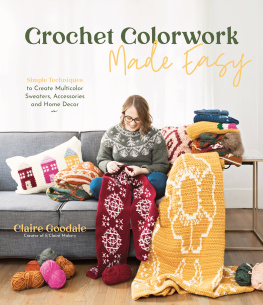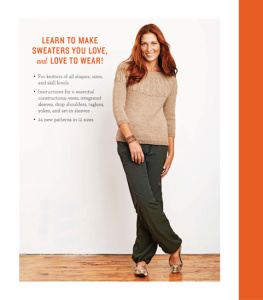2/2 LPC: slip 2 sts purlwise to cable needle, hold to front of work, p2, k2 sts from cable needle
2/2 RPC: slip 2 sts purlwise to cable needle, hold to back of work, k2, p2 sts from cable needle
3/3 LC: slip 3 sts purlwise to cable needle, hold to front of work, k3, k3 sts from cable needle
beg: beginning
BO: bind off
c3 (cluster 3): slip 1 st purlwise, k2, pass slip stitch over both1 st decd
CC: contrast color
CO: cast on
cont: continue; continued
dec(d): decrease(d)
inc(d): increase(d)
k: knit
k1tbl: knit 1 through back loop
k2tog: knit 2 sts together1 st decd
kfb: knit into front and back of same st1 st incd
kwise: knitwise
kyok (knit, yarn over, knit): (k1, yo, k1) in same st2 sts incd
LH: left hand
LT (left twist): slip 2 sts knitwise, 1 at a time, to RH needle; slip back to LH needle, knit 2nd st through back loop, leaving st on needle, then knit both sts together through the back loops
m: marker
M1 (make 1): insert LH needle from front to back under horizontal strand between last st worked and next st on LH needle, knit through back of resulting loop1 st incd
MC: main color
p: purl
p1tbl: purl 1 through back loop
p2tog: purl 2 together1 st decd
patt(s): pattern(s)
pfb: purl into front and back of same st1 st incd
pm: place marker
pwise: purlwise
rep: repeat
Rev St st: reverse stockinette stitch
rnd(s): round(s)
RH: right hand
RS: right side
RT (right twist): k2tog, leaving sts on needle, knit 1st st again
s2kp: slip 2 sts together knitwise, k1, pass both slip sts over2 sts decd
sl: slip
sm: slip marker
ssk: slip the next 2 sts, knitwise, 1 at a time, to RH needle; slip back to LH needle without twisting and knit them together through the back loop1 st decd
St st: stockinette stitch
st(s): stitch(es)
tog: together
WS: wrong side
wyib: with yarn in back
wyif: with yarn in front
yo (yarn over): bring yarn to the front, wrap it over the top of the RH needle, and work next stitch
W ith special thanks to my sample knitters: Brenda Pirie, Chaitanya Muralidhara, Chris Gagnon, Dolly Quinn, Heather Risher, Karen Verbenko, Kari Bhana, Kelly Asfour, Kristin Bellehumeur, and Stacie Berard. I could have not done this book without your nimble fingers.
To my tech editors Heather Anne Zoppetti and Britt Schmiesing, thank you for making the numbers make sense and helping me through this crazy process.
To my friends and colleagues who cheered me along the waywith special thanks to Angela Tong, Dawn Frazier, and Rose Tussing for your support toward the end, when life began to throw me all the curveballs.
W hy are top-down sweaters better? Well, it just comes down to one thingfit. When you knit your sweater in pieces from the bottom up, you cant really try it on. I mean, I guess you could have one of those life-size mannequins that you could pin the pieces to... but who really does that? With a top-down sweater, you can put it on waste yarn or long cables and actually try it on, to know that it well and truly fits or to know the sleeves need to be longer (unless you want to show off that wrist tattoo that your grandma doesnt know you have). Also, unless you are a speed demon, knitting a sweater is a huge time investmentnot to mention the cost of the materials. So make yourself or your loved one a sweater that fits. Knit it top down.
This book has two kinds of sweaters: raglan and yoke style. Whats the difference? Well, in a raglan-style sweater, all the increases are worked along four lineskind of like your classic old-school baseball T-shirt. With a yoke sweater, you space the increases out evenly around the sweater in order to have a yoke that fits around your shoulders and upper body. Which is easier? Sometimes I think raglans are easier to knit because its easy to keep track of the increases. But speaking as a designer, yokes are so much easierespecially when you need a sweater that will fit more than one size of human.
I tried to do a good range of sizes for these sweaters. Most of them go from about a 32-inch to a 56-inch / 81.5-cm to a 142-cm finished bust size. What bust size should you knit? How big is your bust? I know, I know, such a personal question. When you measure your bust, please measure the biggest part of your bustnot your bra band, but around the fullest part of your bust. Then decide how tight or loose you want the sweater to be. And then choose a size that is exactly the size of your bust (keeping in mind that knitting is stretchy!) or a few inches smaller or larger, depending on how you want it to fit. If you ever have questions about which size might be best for you, feel free to shoot me an email at .
And, finally, one of my favorite things about top-down sweaters is the lack of seaming. Really, the only thing you end up seaming is under the arms. And if you are sneaky and pick up your sleeve stitches from the underarm cast-on for the body, you can even avoid that. But I cant help you with the weaving in of ends. That just has to be done.
Needle Notes
What kind of needles should you use for your top-down sweater? First off, and most important, you should use the size that gets you gauge. I dont care if I suggest an 8 and you need a 6. Get gauge! Its so important to make sure your sweater fits that it doesnt matter whether your needle size is wildly different from the suggested one. Your gauge has to work! You want a fabric that you like, of course, but if the gauge doesnt match the pattern, your sweater wont fit.
All of the sweaters in this book have sleeves or sleeve edgings worked in the round. Yes, even the cardigans do, where the body is worked flat. So you need to have access to your favorite method for working small circumferences in the round. Maybe you like dpns (double-pointed needles) or maybe, like me, you prefer magic loop. Use whatever works best for you.
For any pullovers, you will probably need two circular needles, one small enough for the cast-on/neckline area and one that is slightly smaller than your bust size. For example, if you are working a 36-inch / 91.5-cm bust, you will want to use a 32-inch / 81.5-cm circular needle. We dont want your knitting stretched out! You can work the neckline on dpns or magic loop style as well, if you prefer.
For cardigans, I highly suggest using circular needlesyes, even for the flat yoke/raglan area and body. Why? Because you are going to have a lot of stitches on those needles, and I really dont think you could manage them on straight needles. Now you may be a knitting magician and can make it work... but make it easy on yourself (and your wrists) and use circular needles for knitting flat. The nice thing about the cardigan styles is that you can just pick the one lengthagain slightly smaller than the bust you are workingand do all the knitting but the sleeves.
I love a good interchangeable set for knitting top-down sweaters! Its nice to be able to switch the cable lengths whenever I want. So grab your favorite circular knitting needles and get started!
Interchangeable Increases
Do you know what all top-down sweaters have in common? There are increaseslots and lots of increases. You start with just neck stitches, and then you increase like crazy until you have enough stitches for almost your entire bust and upper arms, and then there is some knitting magic and you make a sweaterta-da! But seriously, there is so much increasing. The patterns in this book dont use any super fancy increases, but you can change things up if you like to make the sweater your own.




